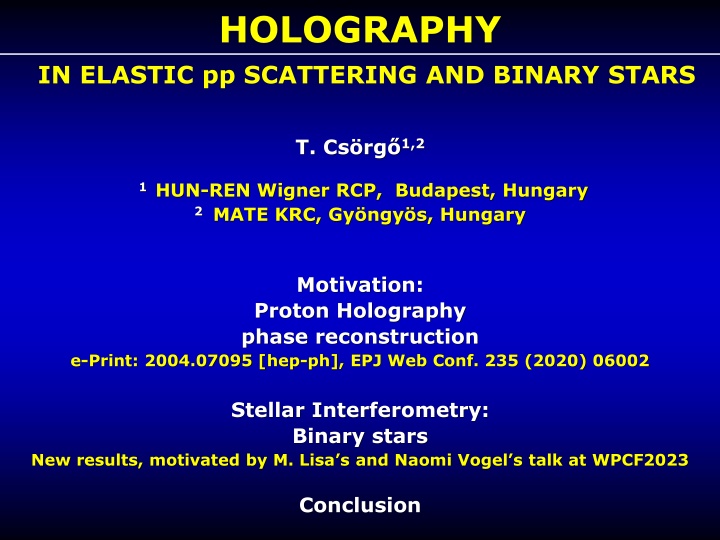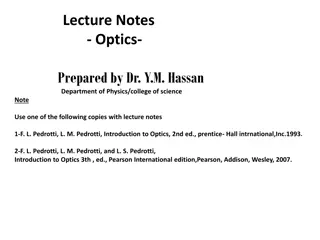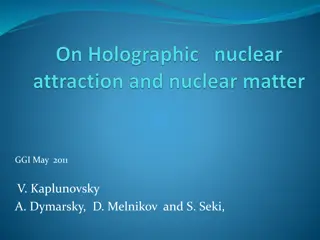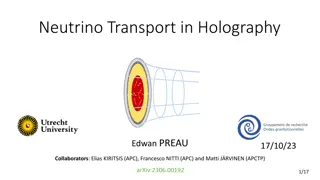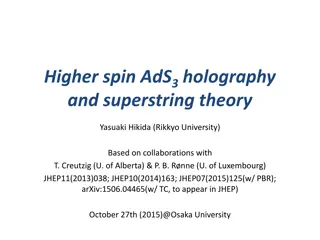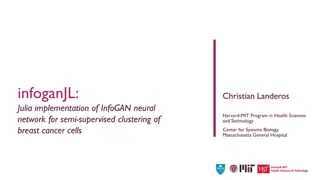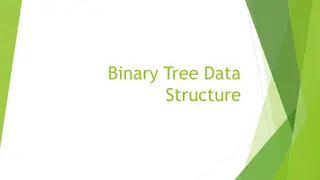HOLOGRAPHY
Proton holography phase reconstruction is discussed in this study conducted in Budapest, Hungary. The research focuses on advancements in utilizing holography in elastic scattering and binary stars. The findings emphasize the innovative applications of holographic techniques in exploring the behavior of protons in different scenarios. The significance of phase reconstruction and its implications are highlighted, providing valuable insights into the field of holography and its practical applications. The e-Print from 2004 offers a comprehensive overview of the research conducted on this subject, shedding light on the intricate details of proton holography.
Download Presentation

Please find below an Image/Link to download the presentation.
The content on the website is provided AS IS for your information and personal use only. It may not be sold, licensed, or shared on other websites without obtaining consent from the author.If you encounter any issues during the download, it is possible that the publisher has removed the file from their server.
You are allowed to download the files provided on this website for personal or commercial use, subject to the condition that they are used lawfully. All files are the property of their respective owners.
The content on the website is provided AS IS for your information and personal use only. It may not be sold, licensed, or shared on other websites without obtaining consent from the author.
E N D
Presentation Transcript
HOLOGRAPHY IN ELASTIC pp SCATTERING AND BINARY STARS T. Cs rg 1,2 1 HUN-REN Wigner RCP, Budapest, Hungary 2 MATE KRC, Gy ngy s, Hungary Motivation: Proton Holography phase reconstruction e-Print: 2004.07095 [hep-ph], EPJ Web Conf. 235 (2020) 06002 Stellar Interferometry: Binary stars New results, motivated by M. Lisa s and Naomi Vogel s talk at WPCF2023 Conclusion
INTRODUCTION: HOLOGRAPHY 2 Basic idea of holography (1947): amplitude level reconstruction. First hologram (1948) from D. Gabor s Nobel lecture (1967). https://www.nobelprize.org/uploads/2018/06/gabor-lecture.pdf
Formalism: elastic pp scattering 3 Basic problem: d /dt measures an amplitude, modulus squared. Amplitude level reconstruction??? Phase info apparently lost
MODEL INDEPENDENT LEVY EXPANSION non-exponential behavior (NEB) in a single parameter idea: complete set of orthonormal functions, put NEB to the weight T. Cs rg , R. Pasechnik, A. Ster, arxiv.org:1807.02897 Eur.Phys.J.C 79 (2019) 1, 62 4 Levy series ~ Taylor series: orthonormal wrt w(z) = exp(-z ). T. Cs., R. Pasechnik, A. Ster, arXiv:1807.02897, arXiv:1811.08913, arXiv:1902.00109, arXiv:1903.08235
ABILITIES: CONVERGES TO pp d /dt @ 13 TeV 5 Levy series ~ Taylor series: orthonormal wrt w(z) = exp(-z ). T. Cs., R. Pasechnik, A. Ster, arXiv:1807.02897, arXiv:1811.08913, arXiv:1902.00109, arXiv:1903.08235
CONVERGENCE PROPERTIES OF LEVY SERIES Partial sum converges both in pbarp (n=3) and also in pp (n=4) 6 Partial sum converges to profile function P(b) and slope B(t) T. Cs., R. Pasechnik, A. Ster, arXiv:1903.08235
CONVERGENCE OF PHASE RECONSTRUCTION Levy expansion converges to the phase (t): Proton holography ?! Cross-check with Coulomb-Nuclear Interference at t=0 successful! Deeper level of understanding in progress, but stop here for now. 7 T. Cs., R. Pasechnik, A. Ster, arXiv:1903.08235
SUMMARY 1: PROTON HOLOGRAPHY 8 Levy expansion converges to the phase (t): Proton holography ! T. Cs., R. Pasechnik, A. Ster, arXiv:1903.08235, ISMD 2018, EPJ Web Conf. 206 (2019) 06007
INTENSITY INTERFEROMETRY FOR BINARIES 9 Stellar interferometry results, HESS, talk of Naomi Vogel@ WPCF23: Fits a BINARY star with intercept parameter = 1 But this is a puzzle, see R. Hanbury Brown et al, MNRAS (1974) 167, 121
HBT FOR BINARY AND MULTIPLE STARS Core-halo picture: T. Cs, B. L rstad and J. Zim nyi, Z.Phys. C71 (1996) 491-497 J. Bolz et al, Phys.Rev.D 47 (1993) 3860-3870 10 Fig. 7 from G. Baym s review paper: arXiv:nucl-th/9804026 Schematics of HBT for multiple stars, but no formula. Note: intercept!
HBT FOR MARGINALLY RESOLVED STARS Partial resolution of the components from W. Guerin et al, MNRAS 480, 245 250 (2018) 11 Reduction of average measured intensity reduces: R. H. Brown and R. Q. Twiss, Brown, R. Hanbury, and R. Q. Twiss: in Proceedings of the Royal Society of London. Series A, Mathematical and Physical Sciences (1958): 291-319.
HBT EFFECT FOR IDENTICAL TWIN STARS Normalization: FT(s|q = 0) = 1 Stellar model: uniformly illuminates sphere Normalization: C(q = 0) = 1 +1 but with an oscillating prefactor 12 Binary source formalism: binary sources in hydro (Cooper-Frye) Schematics worked out for identical stars, e-Print: hep-ph/0011320 Detailed review including hydro results with two saddle points in hep-ph/0001233
HBT FOR BINARY AND MULTIPLE STARS 13 R. Hanbury Brown, J. Davis and L. R. Allen, MNRAS (1974) 167 121 Note: f1 = I1/(I1+I2), f2 = I2/(I1+I2), etc HEP connection
HBT FOR NON-IDENTICAL TWIN STARS Similar, but two sources have different sizes, but with Stellar model: uniformly illuminates sphere or any unknown shape An oscillating prefactor remains, and averages to Binary source formalism: effective reduction of intercept for well separated compact sources Effectively = (q) 1 Schematics works even for out non-identical stars, observations of N. Vogel explained 14 Multiple n source, well separated compact sources Easy to show: 1/n = n(q) 1
SUMMARY FOR BINARY STARS 15 Stellar interferometry results, HESS, from N. Vogel s talk @ WPCF23: Fits with intercept parameter 1 possible, puzzle resolved.
